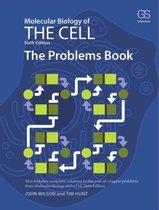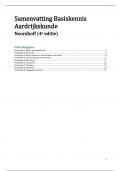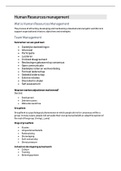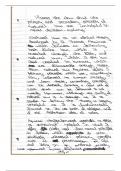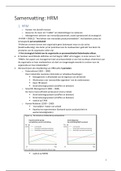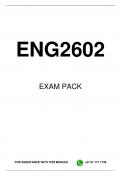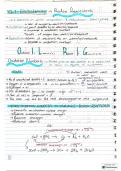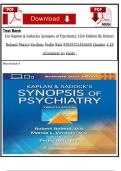23 september 2019
H10 Membrane structure
Eukaryotic cells contains several organelles. The cell is
enclosed by a membrane. Membrane that enclosing the cell
calls the plasma membrane. The nucleus contains the DNA
in a eukaryotic cell. The nuclear membrane is a double
membrane there is an inner membrane and an outer
membrane. The membrane that enclose the nucleus is
called the nuclear envelope. The membranes of the nucleus
are in connection with the membranes of the
endoplasmatisch reticulum. The membrane of the
endoplasmatisch reticulum is also a double membrane. Figure 12-1 Molecular Biology of the Cell (© Garland Science 2008)
The black dots that are attached to the ER membrane are ribosomes -> Ribosomes are bound to
the ER. Ribosomes in the ER are with ER-bound ribosomes and ribosome in the cytosol are the
free ribosomes. The ribosomes in the cytosol are a different types of protein than the ribosomes
attached to the ER membrane. The several ribosomes have each different tasks.
The Golgi apparatus -> the vesicles (blaasjes) split from the ER travels from the ER to the Golgi
apparatus and travel to other destinations in the cell.
There are also peroxisomes in the cell -> contain many proteins and are available by oxidation /
oxygen processes.
Lysosomes are very important by degradation of food products -> break down macromolecules.
(polypeptides, fatty acids etc.)
All the organelles of eukaryotic cell are available in the cytosol -> liquid in a cytocell. The cytosol
and all the organelles together -> cytoplasma. Constituents of biological membranes: lipid and protein molecules
Organelles are only present in eukaryotic cells and not in prokaryotic
cells.
The plasma membrane is a double layer that surrounds the cell. The
membrane has two halves of lipids -> an inner leaflet and an outer
leaflet. phospholipids have a polar head groups and hydrophobic tails.
The hydrophobic tails are on the inside to each other and the polar
head group are to the outside. The polar head groups are in contact
with water. In a membrane are membrane proteins present -> receptors
and can give signals or the proteins can have a transport function.
Membrane lipids are amphiphilic molecules
The membrane is very important. The plasma membrane can
function as a transporter. The membrane contains also proteins to
plasma membrane: 50% of mass is protein
regulate the transport -> Transport proteins. 50% is proteins and
50% lipids -> mass membrane. The plasma membrane is made of
lipid molecules -> phospholipids. The tail can be straight or banded.
Banded is with a double binding -> often in a cis configuration. This
is one example of a lipid there are more sorts of membrane lipids
this one contains a choline, phosphate and glycerol and the fatty
acids. Each lipid has a specific head group in this example the
choline is this group -> amine. The tails are hydrophobic -> would
like to be present in oil or membrane. -> phosphatidylcholine.
Pagina 1
,There are more structure present for membranes. -> four Four major phospholipids in mammalian plasma membranes
major phospholipids in plasma membranes.
There can also be a serine head group -> phosphatidylserine
-> negative charge -> negative charge lipid is always present
on the inside of a membrane -> the inner leaflet and is never
present in the other leaflet. The inside of a membrane is
negatively charge.
phosphatidylethanolamine -> the head group is an ethanol-
amine.
Sphingomyelin -> Hasn’t a glycerol but another group. There
is also a membrane with a fatty chain instead of a fatty acid.
The fatty chain doesn’t contain a acid group. There is a
phosphate group and a choline head group. Lipid molecules spontaneously aggregate in water
Je hoeft deze structuren niet te herkennen
If you put a phospholipid in water with one tail it will create a micelle
-> spontaneously. (zeep)
If you put a phospholipid in water with two tails it will create a bilayer
-> spontaneously.
Some lipids are only present in the outer membrane (leaflet) and
some lipids are only present in the inner membrane (leaflet)
phospholipids
The spontaneous closure of a phospholipid bilayer
The phospholipid bilayer will spontaneously close (fold) on itself and
create a boll -> this takes care that none of the hydrophobic tails are exposed
to water. If the hydrophobic tails will be in contact with water this will be
energetically unfavorable and when it is folded it is energetically favorable.
A liquid bilayer is not solid but it is fluid -> very flexibel -> are able to change
its shape. The lipids can travel in their own leaflet. The lipids can’t never go to fundamental to the creation
of a living cell
the other side of the membrane. -> energetically unfavorable.
The lipids can move in their own side of the membrane and do also rotate
around themselves and in their leaflet. The lipids do not go from one leaflet to
the other leaflet.
The fluidity changes with the temperature. If the temperature of the membrane goes up -> it
becomes more fluid -> fluidity increases. In the night -> colder -> less fluid than on the day ->
warmer -> more fluid. Temperature changes. Chains longer -> more hydrophobic interactions and
Chains less fluid. When chains length goes down fluidity goes up. More double bonds more fluidity
in the membrane -> more double bonds there is a angle and less interaction -> more fluid.
You need to know that there are 4 types of membrane and 1 is negatively charge ->
phosphatidylserine -> always present in inner leaflet. Fluidity of the membrane can depend on the
number of double bonds, length of the chains and the temperature of the membrane.
There is also cholesterol available in the membrane it is not a phospholipid.
It doesn’t have a phosphor bind and doesn’t have a glycerol bind. There is a
very tiny polar head group. There are four ring structures in cholesterol and
it has a non polar hydrocarbon tail (not a fatty acid tail). Cholesterol is sitting
in between the phospholipid. It changes the permeability of the membrane.
If there is more cholesterol in the membrane, the membrane becomes less
permeabel to different molecules. Cholesterol fills up the holes between the
lipids. There is the cholesterol stiffened region, the more fluid region and the
polar head groups.
Pagina 2
,There are also Glycolipids -> only present on the
surface of the plasma membrane on the outside of the
cell -> outer leaflet. Glycolipids give a sugar layer on
the outside. Glycolipids contains hydrophobic tails
(fatty chains, fatty acids etc.) connected to a glycerol
connected to sugar lipids (glucose). Glycolipids are
very important for recognition of the cell or other recognition important role in cell communication.
GPI (glycosylphosphatidylinositol) anchor
Glycolipids only available in the outer lipid and creates a sugar layer. The whole outside of the cells
is covered by a sugar layer -> sweet cells
You don’t need to know the structure of glycolipids.
The ways protein are attached to the membrane often called -> glycosylphosphatidylinositol (GPI)
anchor. You need to know what type of protein GPI is -> help to connect proteins or sugars to
membranes.
Cholesterol is a lipid that is only present in eukaryotic cells.
E.coli doesn’t have cholesterol. Phosphatidylethanolamine is
the major phospholipid in the E.coli bacterium. Glycolipids are
present in eukaryotic cells especially in certain compartments
-> lysosomes. Glycolipids are not present in E.coli.
The lipid bilayer is asymmetric. Some lipids are only present in the inner leaflet and some lipids are
only present in the outer leaflet. Phosphatidylserine with the negative charge is only available in
the inner leaflet of the membrane and you never found it in the outer leaflet. Glycolipids are only
present in the outer leaflet (outer membrane). Cholestrol you can find in both halves of the
membrane. Deze 3 moet je onthouden
Membrane proteins -> 50% mass of the plasma Membrane proteins can be associated with the lipid bilayer
membrane. Membrane proteins -> signals and in various ways
transports. The membrane proteins can be attached
to the membrane by a-helixes -> The N-Terminus is
sticking to the outside and the C-terminus is sticking
to the inside -> this is a possibility. Protein molecules GPI
can also be attached by a lipid molecule. So a single
a-helix or an a-helix and a lipid molecule. They can
form multiple a-helixes, b-sheet -> barrel.
You can also have proteins that are only for one half
attached to the membrane. Or proteins that only are
connected by a lipid molecule. Or proteins that are
Release of proteins from the membrane:
attached to the membrane by a GPI anchor. - phospholipase c
GPI (glycosylphosphatidylinositol) anchor
- high salt solution
- detergents
Number 7 and 8 are examples that are indirectly are attached to the membrane and not directly.
Phospholipase c, high slat solution and detergents -> do release proteins from the membrane.
High salt solution can only remove number 7 and 8 from the membrane.
1,2,3,4,5 can only be removed by detergents.
6 can be removed by detergents and/or phospholipase c.
There are 3 types of linkage of a protein to the membrane by lipid anchors.
D) A protein can have linked by the membrane by a myristoyl anchor -> connected by a
peptide bond. Membrane protein attachment by lipid anchors
E) There can also be a thioester linkage between cysteine and
palmitic group. C double bonded O and S -> palmitoyl anchor.
F) Finally there are proteins attached to the membrane by a
thioether linkage -> linkage between cysteine and phenyl
group. -> CH2-S-CH2.
Pagina 3
, Na de eerste pauze
An a-helix is energetically favorable -> There is an optimal of H-bonding between peptide bonds ->
maximized. b-sheets are also available in membranes -> barrel structures -> more a-helixes. Most
proteins use a-helixes for the interactions. One side of an a-helix is more hydrophobic than the
other side of the a-helix.
Hydropathy plots to localize membrane-spanning segments
Membrane proteins need structures amino acids that are fold up
like a-helixes. You can predict the amount of hydrophobic sections
a polypeptide chain.
20% transmembrane proteins
A) you see one positive peak -> means that this amino acid is
large enough and hydrophobic enough to pass the membrane
and leave the cell. Hydrophobic parts can leave easier the
membrane without making use of a transport protein or
something like that. -> 1 hydrophobic region -> glycophorin
B) It can also have multiple hydrophobic parts -> 7. There are also
proteins with multiple hydrophobic regions -> 7 regions. 20% transmembra
proteins
Bacteriorhodpopsin
There are also b-sheets structure which are being used -> forms a pore in the membrane -> barrel
in the membrane. The inside of the barrel is often filled with water / polar etc. and the outside is
often hydrophobic and this touches the membrane -> channel proteins. Channel proteins forms
pores in the membrane and basically allows that molecules pass the membrane from one side to
the other. Channel proteins are present in membranes and regulate that molecules can go in or out
the cell -> transport regulation. The pore can be closed otherwise it is not regulated. (plug) ->
Close when the molecule is transported.
The plug only opens when the molecule is there -> gated ion transporter. Normally its closed and
when a molecule comes it will open.
Some of these proteins can also have enzymatic activity.
Many mammalian (zoogdier) membrane proteins are glycosylated and contain disulfide bonds
Disulfide and sugarlayer are always on the outside of a bilayer/membrane etc.
The sugar layer contains glycolipids and glycoproteins. Glycoproteins -> membrane proteins and
do have sugar units. -> protect cells and communicate with cells.
If you wanna purified membrane proteins. You
add detergents (polar heat group with one
hydrophobic tail) to the membrane -> forms
micelles -> these micelles tend to interact with
the membrane and this means that these
detergents can interact with lipid molecules and it
can also interact with the protein molecule by the
lipid. Many of the lipids of the membrane will
leave and diffuse into the micelles. Lipids are
shielded from water by the detergents. The protein will attache to the
detergent and then you can purify the protein.
Detergents -> SDS -> sodium dodecyl sulfate is a detergent.
Further detergents are Triton X-100 and B-octylglucoside. Detergent forms a
micelle.
You don’t need to know the structure or the names.
If you want to purify a protein you add detergents and you will get a solution of
membrane proteins attached to different detergents. (more info in book)!
Pagina 4

